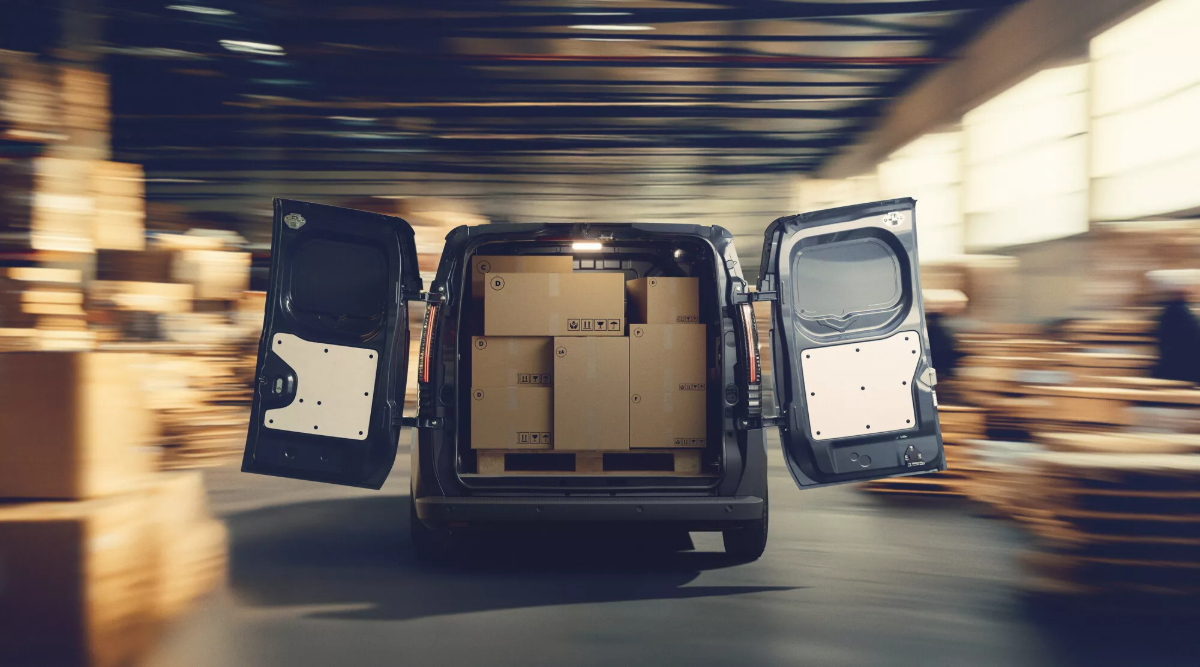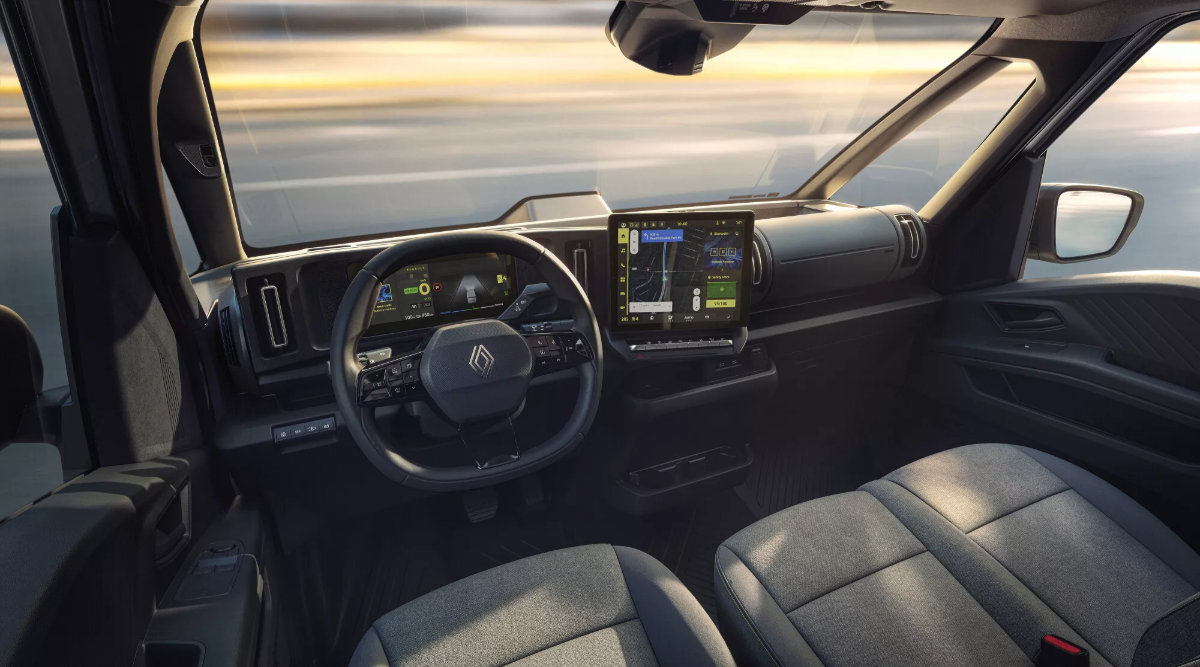Support CleanTechnica’s work through a Substack subscription or on Stripe.
At the Solutrans 2025 auto show in Lyon, France, last week, Renault officially unwrapped its new Trafic E-Tech Electric, a battery-powered commercial vehicle that features an all new skateboard design from Ampere, the Renault division that is responsible for designing, engineering, manufacturing, and marketing “electric tech-driven vehicles that people can afford.” Ampere is responsible for the latest electric vehicle from Renault, the new Twingo.
There are several layers to the press release announcing the arrival of the Trafic E-Tech Electric panel van. First, there is the exterior design of the vehicle, which Renault is pretty excited about. It has been optimized for commercial users. The roof has been raised a bit compared to the current generation Trafic, but it is shorter overall than the Renault Master van. At 1.9 meters (6′ 3″) high, it is still low enough to access most parking garages.
The Trafic E-Tech van will be available in two versions. One is 4.87 meters (16 feet) long and offers 5.1 cubic meters (180 cu ft) of cargo carrying space. The other is 5.27 meters (17′ 4″) long and has a cargo capacity of 5.8 cubic meters (205 cu ft). The difference in length is attributable to the wheelbase of the two versions. The front and rear overhangs are identical in both. The towing capacity is said to be two tons (4400 lb) and the payload is 1.25 tons (2800 lb).

The designers have worked hard to make the E-Tech a user friendly tool for use in crowded urban environments. Because the all new electric motor is in the rear, the engineers have given it the same turning circle as the Renault Clio, a small city car. The motor itself is rated at 150 kW (200 hp) and 345 Nm (255 ft-lb) of torque.
The company raves at some length about the exterior appearance of the Transit E-Tech, but its real beauty is beneath the sheet metal. It is the first Renault vehicle to use 800 volt architecture, which allows fast charging from 15 to 80% in 20 minutes or less. Not only that, the E-Tech will be available with two batteries — one featuring NMC battery cells and 450 km of range (WLTP), and the other with LFP battery cells and 350 km of range (WLTP). Renault says both are capable of V2L and V2G operation, but has not yet said specifically what the capacities of the two batteries are.
Renault & The Software Defined Vehicle

The Trafic E-Tech is a technological marvel. Renault calls it a “Software Defined Vehicle,” but what does that mean, exactly? The new CAR OS operating system was adeveloped by Ampere and is based on the Android Automotive OS. The central software is connected to the cloud and can be updated remotely and in real time. In addition, customization “tailored to the actual use, driving habits and requirements of individual users” is possible for the first time in a Renault vehicle.
That level of customization will allow users to control the operation of individual components. For instance, owners who use the vans for deliveries will be able to integrate their own software into the on-board multimedia system to transmit information about time of arrival, route, contacts, or comments directly to delivery drivers in real time.
Fleet users can log into their profile and access a personalized interface with their preferred vehicle settings and apps. The system can also supply the driver with route information “that takes into account vehicle dimensions and load to avoid unsuitable routes.” Consumption data is also taken into account, which allows the system to suggest optimized loading stops, according to Electrive.
Additional apps are available via the Google Play Store that can be used on the vehicle’s touchscreen, such as the EasyPark payment system or music streaming. The new software platform permits a proactive approach to maintaining the cold chain for refrigerated deliveries. It takes into account detailed real-time information such as the outside temperature and the vehicle’s actual power consumption. If necessary, additional charging sessions will be scheduled to keep the cold chain intact.
“Software is no longer limited to specific functions, as in previous architectures, but shapes the entire vehicle. The centralized software architecture can be updated throughout the vehicle’s lifetime, just like a smartphone or laptop,” Renault says. Production is still almost a year away,but once it begins, the Trafic E-Tech will be available not only as a cargo van but also as a flatbed, tilt bed, or cab-only design that would allow it to be used as a passenger shuttle.
What If…Nissan?
In the US, there are currently no battery-powered urban delivery vans in production. The vehicle Rivian created for Amazon is much too large for inner city use, as is the Brightdrop from GM, which is now out of production thanks to tariff disruptions initiated by the current administration. Kia has the PV5, a versatile commercial vehicle that offers much the same technological goodness as the Renault Trafic E-Tech, but with the current chill between the US and South Korea, the company is not rushing to bring any electric vehicles stateside that are not manufactured in the US. The Kia EV4 is the popular choice for electric Car of the Year, but it too is not being imported to the US.
Despite those headwinds, Bloomberg this morning is musing about something interesting. Renault CEO Francois Provost said in an interview Friday that the agreement Renault and Nissan reached in 2023 to equalize how many shares each holds in the other at 15% has made the two companies more inclined to work together,
“In this context, of course I want to share new, out-of-the-box ideas with Ivan,” Provost said, referring to Ivan Espinosa, his counterpart at Nissan. “As of today, there is nothing new in the works, but for us, any new win-win partnership with Nissan that can feed into Renault’s business plan might make sense.”
“Given its financial fragility and weak product pipeline, external partnerships have become attractive again for Nissan,” Bloomberg Intelligence senior auto analyst Tatsuo Yoshida said. “They are essential for its survival.” Nissan said in an emailed statement that the alliance with Renault remains a cornerstone of its strategy.
Renault’s strength in battery-electric vehicles could help Nissan greatly, according to James Hong, an analyst at Macquarie Securities Korea. “Surviving in the US market is the number one priority. They need scale to invest in these areas, and that’s where they need external partnerships.”
While Nissan has managed to substantially cut costs, it needs to deliver on the sales side, said Julie Boote, an automotive analyst at London-based research firm Pelham Smithers Associates. “If demand for its models can only grow via heavy incentives — as seen in the US in the last quarter — the outlook for Nissan remains bleak, with or without the new projects with Honda and Renault.”
The US is a critical market for Nissan. Is it possible the Renault Trafic E-Tech could be marketed there successfully? Neither Ford, GM, nor Stellantis is currently showing any interest in that segment. Both Ram and Ford offer battery-electric versions of their cargo vans, but those vehicles are considerably larger than the Renault Trafic.
Is there a market in the US for a more compact delivery van, one that features all the latest software capabilities, decent range, fast charging, and the competitive advantages of reduced operating costs? And could Nissan produce it at one of its factories in the US? Those are questions with no answers at the moment, but they do suggest some intriguing possibilities.
Sign up for CleanTechnica’s Weekly Substack for Zach and Scott’s in-depth analyses and high level summaries, sign up for our daily newsletter, and follow us on Google News!
Have a tip for CleanTechnica? Want to advertise? Want to suggest a guest for our CleanTech Talk podcast? Contact us here.
Sign up for our daily newsletter for 15 new cleantech stories a day. Or sign up for our weekly one on top stories of the week if daily is too frequent.
CleanTechnica uses affiliate links. See our policy here.
CleanTechnica’s Comment Policy



